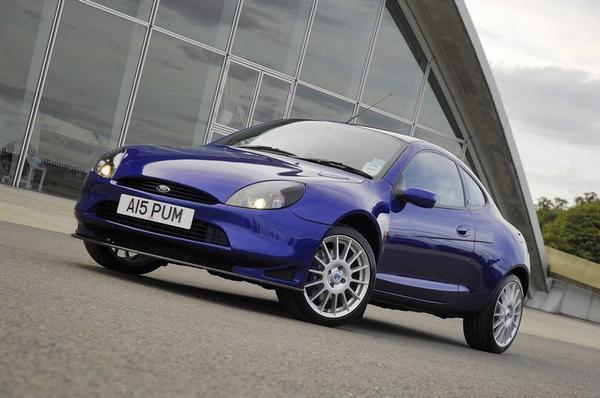Ford Puma | PH Used Buying Guide
On the hunt for a Puma? Pounce on our buying guide first...

It seems almost obscene in these days of spiralling prices for some very so-so mid-1990s sports cars that Ford's Puma can still be had in fine fettle for £1,000. Still, it also means you can enjoy one of the very best driver's cars to emerge from that decade, or any other.
Based on the humble Ford Fiesta chassis, the Puma was nigh on perfect from the moment it was launched in 1997. The press loved it, dealers loved it and buyers thought it brilliant. All of these plaudits were for the 1.7-litre version, which came with variable valve timing courtesy of a cylinder head designed and fitted by Yamaha. It gave the Puma a fizzy, rev-happy nature that suited its superb handling and pin sharp steering.
By comparison, the 1.4-litre base model, and the 1.6 that replaced it in late 2000, just felt too slow to make the most of the handling. Even so, the 1.7 needed 8.6 seconds to get from 0 to 60mph, but the almost metronomic precision of the five-speed manual gearbox let you keep it sparking away around 7,000rpm where peak power of 125hp was produced.

Early Pumas had quite simple fabric upholstery and, in usual Ford fashion, a number of special editions followed with leather seats, fancy body colours and different alloy wheels.
However, the only significant change to the Puma in its all too short life was the launch of the Racing model. It took the 1.7-litre engine to 153hp thanks to a new intake manifold, camshafts, exhaust and ECU. That resulted in 0-62mph in 7.9 seconds and an increased top speed of 126mph over the standard 1.7's 123mph.
In many ways, the Racing Puma didn't feel special enough to warrant the big jump in price, even if the cabin was decked out with excellent Sparco seats trimmed in Alcantara. However, it was the handling that made it shine. The track was 70mm wider and firmer springs made it almost impossible to keep up with on twisty roads. Ford only made 500, all painted Imperial Blue metallic, and a handful were specified with a limited slip differential that makes these cars even more desirable to collectors now.
Search for Ford Pumas here

Due to its rarity, a Racing Puma will cost from £10,000 upwards depending on mileage and condition, but you can be sure prices will continue to rise. For the rest of the Puma breed, you can pick up scabby examples for less than £500, while £1,000 should find you a car in decent nick but with some rust bubbles showing through. Spend twice that and you can bag a very clean 1.7 that will make you smile every time you drive it.
Bodywork and interior
Rust is the natural predator of the Puma. Most of it will be obvious on the rear wheelarches and sills, but also check around the fuel filler and pretty much anywhere else you can see. If caught early, the rear arches are a simple, cheap fix, but if the rot has spread it can be too costly to repair as panels are hard to come by. Also, inspect the boot floor as it was poorly protected from the factory.
The Racing Puma also suffers from corrosion, though most have been more pampered. Its problem stems from the wider rear wings being glued and welded over the original body. Rust happens out of sight, so you need to strip the interior panels to inspect in here. Repair panels are available, but restoring rot here can run to £5,000.
The Racing Puma has aluminium front wings and there are no new panels available, so that means scouring for good used ones if they're damaged
Racing Puma bumpers are made from fibreglass and are very susceptible to knocks, so check them carefully.
The standard car's interior wears well, but the Racing Puma's Sparco front sports seats quickly scuff. Matching the blue Alcantara is a tricky job.

Engine and transmission
Overheating is common due to a faulty thermostat. If the temperature dial fluctuates, replace the thermostat as a preliminary measure.
If the throttle hesitates during a test drive, its position sensor needs replacing, which will cost around £40 for a new sensor.
The 1.7-litre engine is best run on 5W-30 semi-synthetic oil.
Cambelt changes are required every five years or 80,000 miles.
Some 1.7s have suffered from bore wear, so look for smoke from the exhaust, poor starting and oil leaks.
Any misfire is probably due to the HT leads shorting due to coolant leaking on to them.

Suspension and steering
Sloppy, worn bushes ruin the Puma's handling. Original spec replacements are cheap and easy to fit, but a better bet might be polybushes to give a longer lasting fix and firm up the suspension without losing the supple ride.
The Racing Puma gained Eibach springs and Sachs shock absorbers, which are no longer available new.
Wheels, tyres and brakes
Look for uneven tyre wear as a sign of worn suspension.
Alcon supplied the brakes for the Racing Puma and they need a service every 3,000 miles to maintain their excellent bite. The calipers can corrode and repairs will cost up to £700, while front discs are £400 for aftermarket items.
Search for Ford Pumas here
Search for Fords
SPECIFICATION - FORD PUMA
Engine: 1388/1596/1679cc 4-cyl inline
Transmission: 5-speed manual
Power (hp): 89/105/125/153@5500/5500/6300/7000rpm
Torque (lb ft): 92/107/116/118@4500rpm
MPG: 39.0/38.0/38.0/35.0
CO2: 171/171/178/NAg/km
Price new: £14,550
Price now: £500 upwards
Gassing Station | General Gassing | Top of Page | What's New | My Stuff



